Giotto’s frescoes in the Scrovegni Chapel in Padua are highlights of Western art and important in the development of Renaissance art.
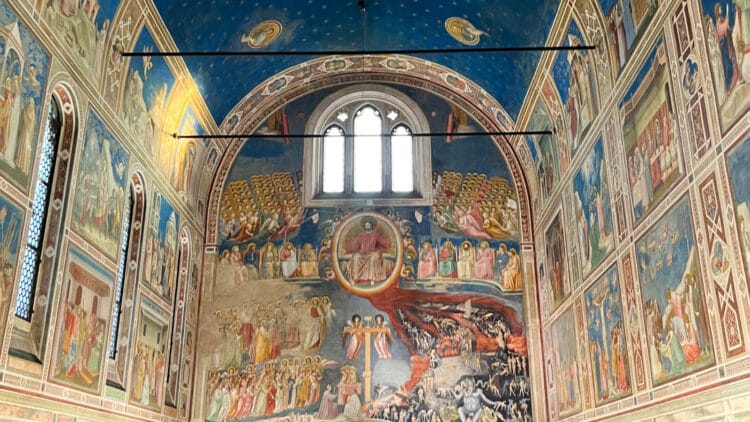
Giotto’s frescoes in the Scrovegni Chapel in Padua (Padova) with scenes from the lives of Christ, Mary, Joachim, and Anne are a tour de force of medieval art. The frescoes transformed the chapel into a visual scripture, blending human emotion with theological clarity. It is a turning point in the history of Western art, marking the shift from the stylized abstraction of Byzantine tradition. The Scrovegni Chapel is a masterpiece of medieval art and a cornerstone of the Italian Proto-Renaissance. Time-slot reservations for the Scrovegni Chapel are not expensive, but you must buy tickets at least a day before visiting.
Scrovegni Chapel in Padua

The Scrovegni Chapel, also known as the Arena Chapel, is one of the most significant monuments of early 14th-century Italy. Located in Padua, near Venice, it was commissioned by the wealthy banker Enrico Scrovegni and built between 1300 and 1303 on the site of a former Roman amphitheater, from which it takes its alternative name.
Enrico Scrovegni’s motives for building the chapel were both religious and reputational. His family wealth was largely acquired through usury, a serious sin, and it is widely believed that the chapel was constructed in part to atone for these moral debts and secure the family’s legacy. (Enrico is portrayed in Giotto’s Last Judgment fresco offering the chapel itself to the Virgin Mary, a symbolic gesture of piety and redemption.)
The chapel, consecrated on March 25, 1305, was originally part of a larger palace complex, most of which has since been lost. The relatively simple, unadorned brick-face exterior contrasts sharply with the stunning artistic program within.
Enrico’s decision to hire Giotto di Bondone, the most innovative painter of his time, proved pivotal in the history of Western art.
Giotto’s frescoes transformed the chapel into a visual scripture, blending human emotion with theological clarity. Their completion marked a turning point away from the hieratic, symbolic style of Byzantine tradition toward a new visual language based on realism, psychology, and spatial coherence.
Today, the Scrovegni Chapel is recognized as a masterpiece of medieval art and a cornerstone of the Italian Proto-Renaissance. It stands not only as a testament to individual patronage but as a milestone in the development of Western visual culture. It was inscribed on the UNESCO World Cultural Heritage list in 2021.
Giotto’s Frescoes in the Scrovegni Chapel: A Masterpiece of Visual Narrative
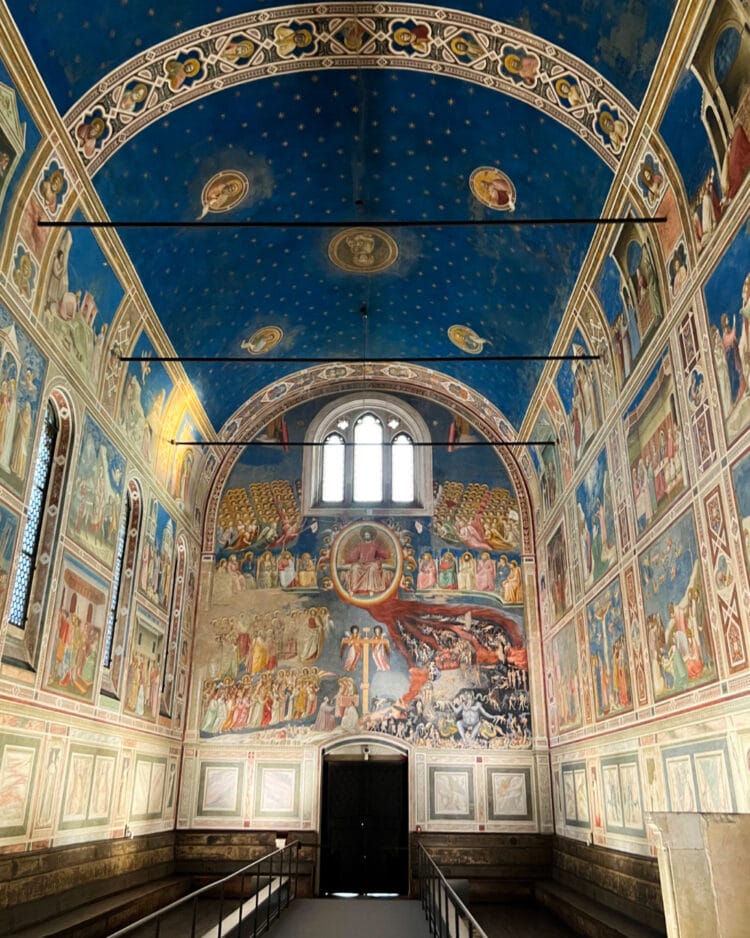
The Scrovegni Chapel in Padua is adorned wall-to-wall (and ceiling) with the groundbreaking fresco cycle of Giotto di Bondone (c. 1267-1337), painted between 1303 and 1305. This monumental ensemble stands as a turning point in the history of Western art, marking the shift from the stylized abstraction of Byzantine tradition to a more human-centered, emotionally expressive, and spatially coherent visual language.
The chapel’s interior is a rectangular space with a barrel-vaulted ceiling, its entire surface animated by Giotto’s frescoes. The nave is ca. 21 metres (69 ft) long, 8.4 metres (28 ft) wide, and 12.65 metres (42 ft) high.
The cycle is organized in three narrative bands that wrap around the walls, moving from top to bottom in a continuous visual flow. The various scenes are fairly large, measuring mostly 200 by 185 cm (79″ x 73″).
The central narrative focuses on:
- The life of the Virgin Mary and her parents, Joachim and Anne.
- The life of Christ.
- The Passion and Resurrection of Christ.
A large Last Judgment fresco covers the west wall, while the virtues and vices are in monochrome grisaille at the bottom of the nave walls.
The frescoes in the altar area are not by Giotto and illustrate the death and coronation of Mary, while the sculptures are by the talented Giovanni Pisano.
Ceiling Frescoes of the Scrovegni Chapel
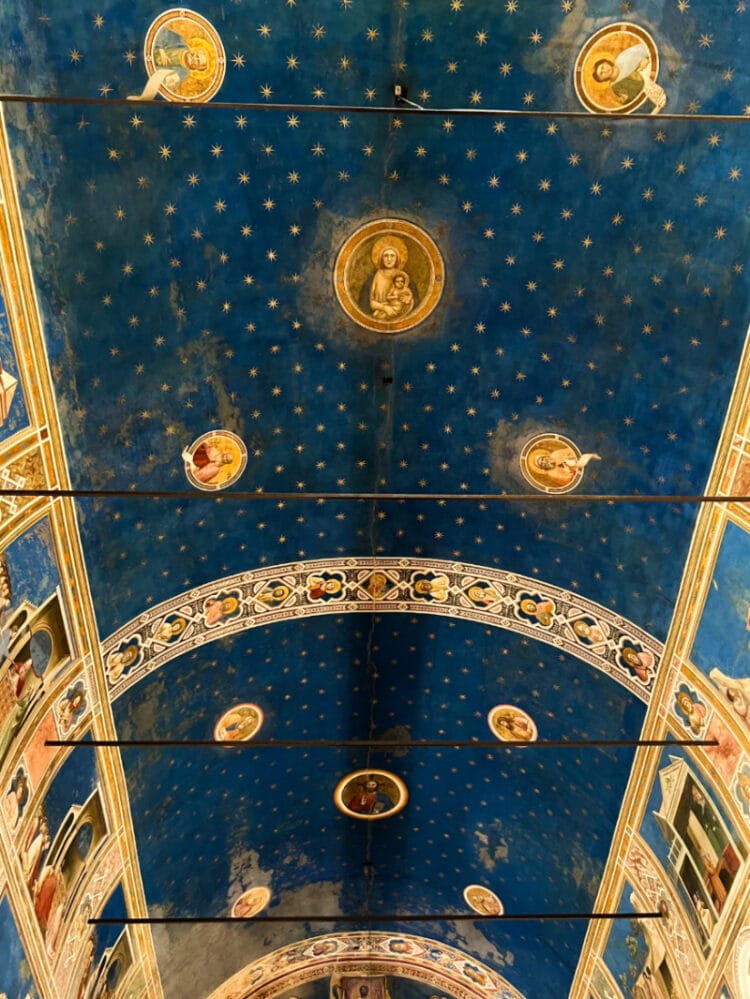
The ceiling fresco of the Scrovegni Chapel by Giotto is a striking example of celestial iconography, divided into four deep blue barrel-vaulted sections richly adorned with stars and medallions. The dominant background is a deep ultramarine blue, symbolizing the heavens, punctuated by delicate, symmetrical eight-pointed gold stars that evoke the divine realm. This starry sky envelops the chapel’s visitors in a vision of eternity, creating a visual contrast to the more narrative scenes depicted on the walls.
Within the vault are ten circular medallions with busts of Christ, the Virgin Mary, John the Baptist, and seven Old Testament prophets. Each medallion is framed by intricate geometric borders and symmetrically arranged along the central spine of the vault and within the triangular spaces created by the intersecting arches.
The ribs separating the vault sections are painted to imitate architectural moldings, further emphasizing the structure of the ceiling. Small decorative motifs in the spandrels and intersections add visual complexity without distracting from the clarity of the composition. These are mostly of angels and saints.
The overall effect is immersive: the viewer is enveloped in a dome of sky that lifts the eye upward and symbolically connects the earthly church with the divine. The ceiling’s restrained yet luminous design provides a spiritual canopy over the vivid narrative frescoes that line the chapel’s walls.

Life of the Virgin Frescoes in the Scrovegni Chapel
Giotto’s fresco cycle begins on the uppermost register of the south and north walls, narrating the life of the Virgin Mary, starting with her parents, Joachim and Anne, and continuing with Mary’s early life and marriage. Most of these scenes are not in the standard Bible or described in the four Gospels.
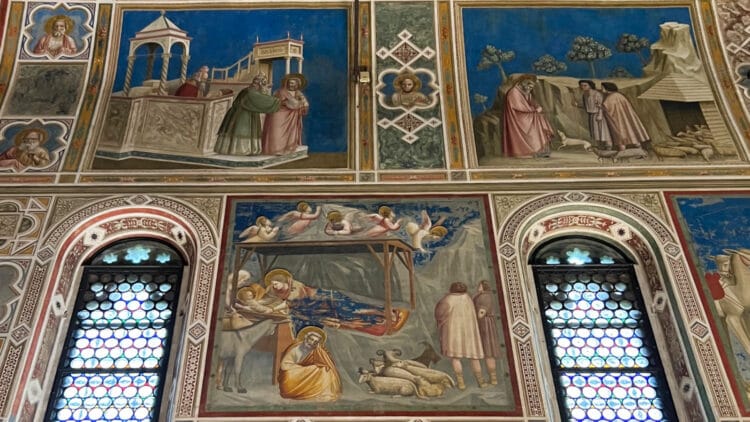
Joachim and Anne
On the south wall, starting from the triumphal arch:
- Joachim’s Sacrifice Rejected at the Temple
- Joachim Among the Shepherds
- An Angel Appears to St. Anne
- Joachim Sacrifices a Kid Goat to the Lord
- An Angel Appears to St. Joachim
- Joachim and Anne Meet at the Golden Gate
The first scene, Joachim’s Expulsion from the Temple, shows Joachim turned away in shame (for being childless), depicted with poignant body language and isolated composition that emphasizes his alienation.
In the Annunciation to Saint Anne, a shaft of golden light bridges the gap between heaven and earth, symbolizing divine intervention with astonishing simplicity.

One of the most tender moments in the cycle is the Meeting at the Golden Gate of Jerusalem, where Joachim and Anne embrace upon learning they will have a child. Giotto distills the human essence of this divine message into a touching display of love and relief, capturing their faces in profile as they touch foreheads in a moment of sublime stillness. This is often described as the first true kiss in European painting.

Giotto: Meeting at the Golden Gate
Giotto’s fresco Meeting at the Golden Gate in the Scrovegni Chapel in Padua, depicting St Joachim and St Anne, is often considered the first kiss in Renaissance art, or even the first emotive kiss in Western painting. It marks a turning point: the beginning of art that sees love not only as a symbol, but as a human experience.
It is, of course, not the first kiss ever painted in Western art, as scenes of betrayal (like Judas kissing Christ) appear earlier in manuscripts and frescoes. However, it is arguably the first romantic or marital kiss portrayed with such psychological subtlety and physical realism.
→ See also: Life of Joachim and Anne: Parents of the Virgin Mary for more on these figures not described in the standard bible, as well as their portrayal in art.

The Life of the Virgin Mary
On the north wall, top level, starting from the Last Judgment:
- Birth of the Virgin Mary
- Presentation of Mary in the Temple
- Rods Brought to the Temple
- Prayer of the Suitors and the Blossoming of Joseph’s Rod
- Betrothal of Mary and Joseph
- Wedding Procession
Scenes such as the Birth of the Virgin, Presentation of the Virgin, and Marriage of the Virgin unfold in architecturally defined spaces. Giotto uses simplified yet effective buildings to structure the narrative, create depth, and anchor the figures. His treatment of space, though not governed by linear perspective, represents a clear move toward spatial realism.
The Life of Christ Frescoes

The middle register presents key episodes from the public ministry of Christ from his birth until the entry into Jerusalem and culminating in the Passion and Resurrection on the bottom register. Giotto arranges each scene with a remarkable economy of means, using pared-down compositions and focused gestures to communicate spiritual meaning.
Annunciation and Visitation

The story starts on the triumphal arch with The Annunciation split into two panels: Gabriel on the left side and Mary to the right of the arch. On the right-hand side of the arch, in the Visitation, Mary and Elizabeth clasp hands and gaze into each other’s eyes, imbuing the scene with dignity and quiet joy.
In contrast to the earlier scenes, these two events and the rest are from the standard Bible. They are familiar to Christians of all denominations and are frequent themes in Western art.
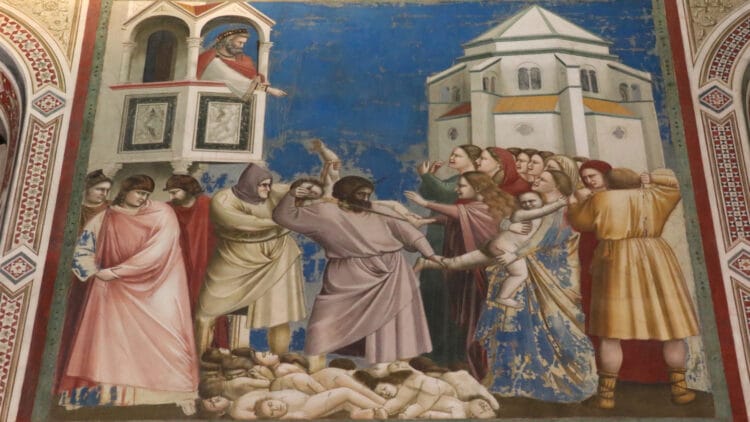
On the south wall, familiar scenes from the early years of Christ’s life:
- Nativity (Birth of Christ)
- Adoration of the Magi
- Presentation of Jesus at the Temple
- The Flight into Egypt
- Massacre of the Innocents
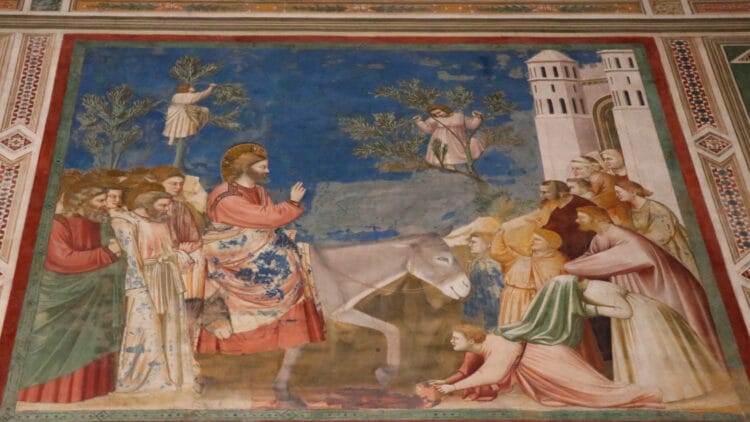
Continuing on the north wall with:
- The Young Christ in the Temple
- Baptism of Christ
- Wedding at Cana
- Raising of Lazarus
- Entry into Jerusalem
- Expulsion of the Money Changers
In the Wedding at Cana, Christ blesses the wine while guests react with gentle surprise—each face uniquely characterized.
In the Raising of Lazarus, Christ stands firmly as he calls Lazarus from the tomb. Onlookers recoil; one figure even covers his nose. The miracle is shown not through divine theatrics, but through deeply human reactions.
The Entry into Jerusalem achieves a strong sense of movement. Children climb trees, cloaks are laid before Christ, and architecture frames the action. Giotto’s figures are monumental yet subordinate to narrative clarity, creating unity through gesture and composition.
Passion, Death, Resurrection
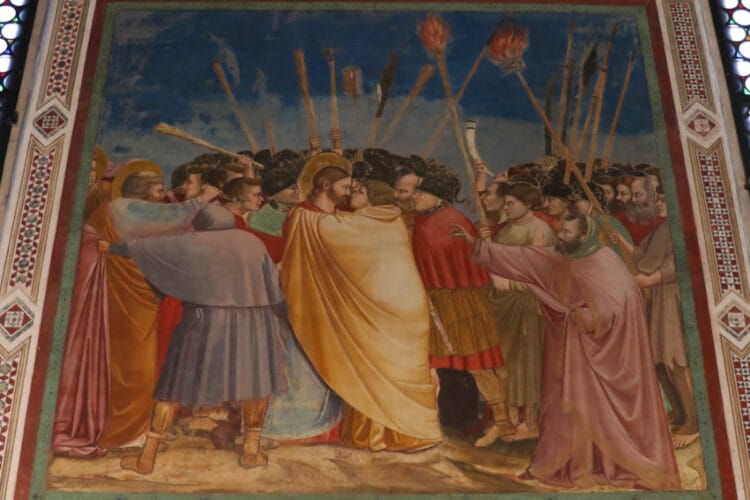
The lowest band contains the most intense and emotional moments: Christ’s Passion, Crucifixion, and Resurrection. Giotto’s treatment of these scenes is masterful in its dramatic pacing, psychological acuity, and visual clarity.
It starts already on the left-hand side of the triumphal arch with the Betrayal of Judas (with a dark devil at his back) before continuing on the lower band of the south wall with:
- The Last Supper
- Washing of the Feet
- The Kiss of Judas
- Christ Before Caiaphas
- Flagellation
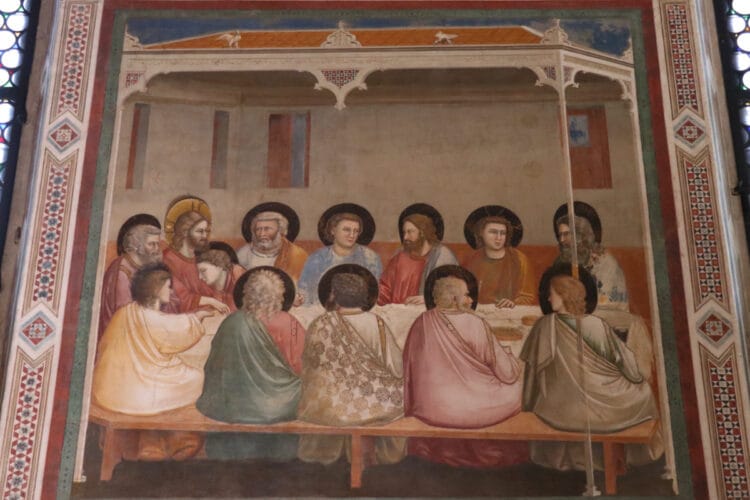
The Last Supper is hushed and tense. Judas sits apart, his sullen profile isolating him. Giotto creates foreboding with minimal gesture. It is quite different from the more famous The Last Supper of Da Vinci in Milan.
In the Kiss of Judas, a golden-robed Judas embraces Christ. The confrontation is central, eye to eye. This is in stark contrast to the romantic kiss of Joachim and Anne at the Golden Gate. Soldiers press in; chaos erupts around this moment of betrayal. The golden robe encasing Christ intensifies the sense of entrapment.
Crucifixion and Resurrection

On the north wall:
- Christ Carries the Cross
- Crucifixion
- Lamentation (Deposition)
- Resurrection (Noli Me Tangere)
- Ascension
- Pentecost
The fresco of the Crucifixion is stark. Mary collapses into grief, supported by her companions. On the opposite side, soldiers and spectators observe. Christ’s limp body pulls the viewer’s gaze upward—a silent declaration of death and transcendence.

Perhaps the most iconic scene is the Lamentation. Mary cradles Christ’s lifeless body at the base of a diagonal rock that draws the eye downward. Around her, mourners express grief through vivid, individualized gestures. Angels in the sky twist in torment. The emotional impact is immediate and profound.
Post-Resurrection scenes like Noli Me Tangere and the Ascension offer visual resolution. Christ appears radiant and transformed. Giotto conveys divine majesty through restraint, movement, and gesture.
Giotto’s The Last Judgment Fresco in the Scrovegni Chapel
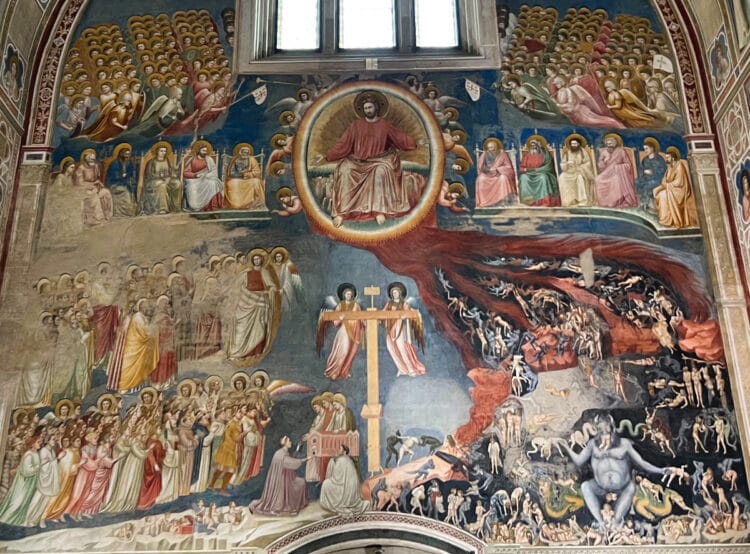
Dominating the west wall is the grand Last Judgment. Christ in Majesty sits within a mandorla, flanked by angels and apostles. The saved are gathered into the celestial city; the damned fall into hell below. At the top, angels are rolling away the curtain to reveal the heavenly New Jerusalem.
This scene contrasts sharply with the narrative restraint of the side walls. It is apocalyptic, detailed, and didactic. Satan presides over the torments of the damned—biting, burning, devouring. Yet the overall composition remains symmetrical and legible, reinforcing divine justice rather than fear.
Dante and Scrovegni
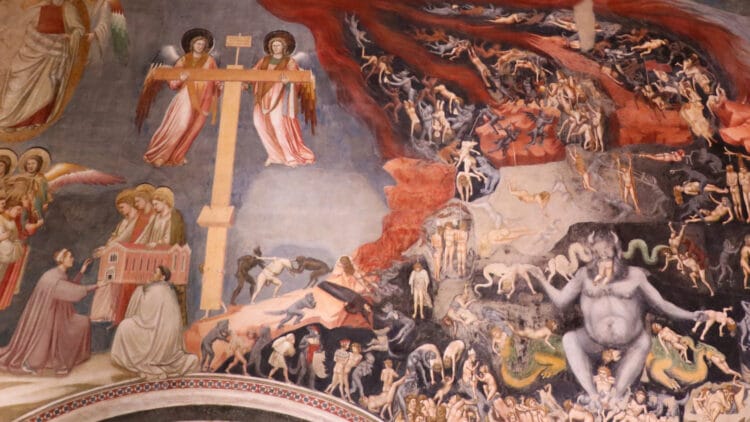
At the lower center, Enrico Scrovegni presents the Virgin with a model of the chapel. On the other side of the cross, a man is being undressed. Getting naked seemed to have been seen as the first step into hell. The man hanging nearby with his guts spilled represents Judas.
The Last Judgment fresco is often described as “straight out of Dante,” but Giotto’s Scrovegni Chapel masterpiece preceded Dante’s Divine Comedy. After its publication, Satan is more commonly portrayed with three faces, eating humans through all three mouths simultaneously.
Dante was familiar with the Scrovegni Chapel. The frescoes here possibly encouraged him to place Enrico Scrovegni’s father, Reginaldo, in the 7th circle of hell for his sin of usury.
Virtues and Vices: Moral Allegory in Grisaille
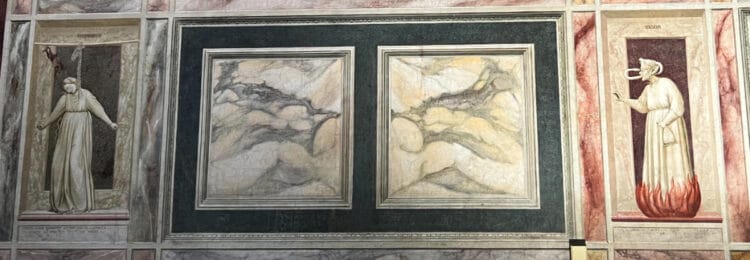
Below the narrative bands, Giotto painted fourteen allegorical figures in grisaille—the Seven Virtues and Seven Vices. These figures, rendered in a sculptural monochrome style, provide a moral framework grounded in ethical choice.
The Seven Virtues of Faith, Charity, Hope, Prudence, Fortitude, Temperance, and Justice are noble, upright, and calm. Across from them, the Seven Vices of Envy, Injustice, Anger, Inconstancy, Infidelity, Despair, and Folly are disfigured or chaotic. Each embodies a warning or a guidepost, tying the theological narrative to individual conduct. As with hell in the Last Judgement, the seven vices were clearly more fun to create.
Altar Area of the Scrovegni Chapel
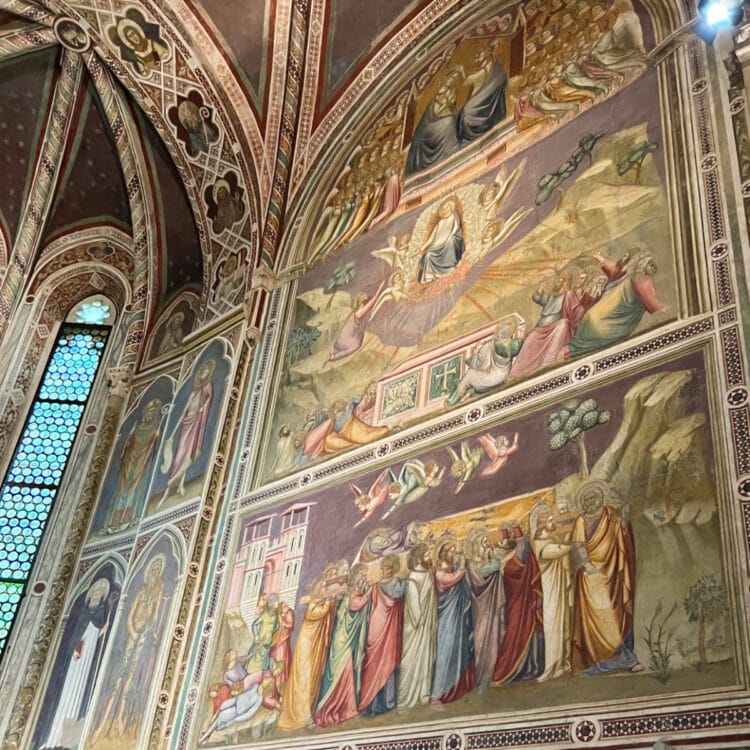
The apse (choir) area of the Scrovegni Chapel was mired in controversy. The adjacent church thought it too large and ostentatious for a private chapel, forcing the destruction of the original larger transept and choir. This area was not decorated by Giotto.
The frescoes are by the unknown Master of the Scrovegni Chapel. They complete the life of Mary with further scenes not in the Gospels (and generally very unpopular with protestant denominations). The main scenes are:
- Announcement of death to Mary
- Greeting of the Apostles at Mary’s bedside
- Dormition of Mary
- Funeral of Mary
- Assumption
- Coronation
Were they not adjacent to the earlier masterpieces by Giotto in the nave, these frescoes probably would have been valued more.
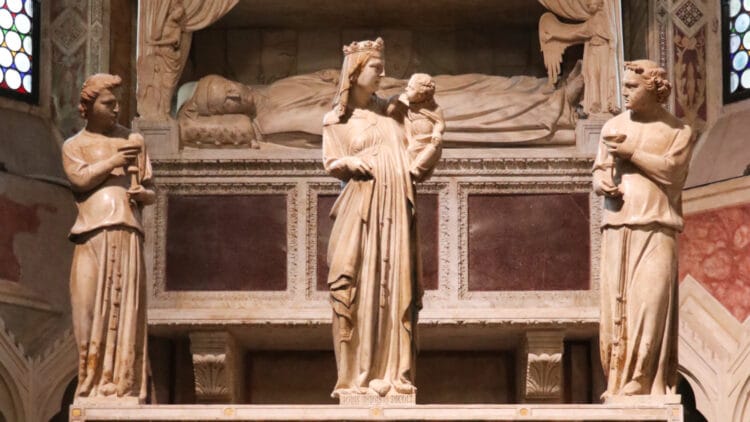
The statues of the Madonna and Child flanked by two deacons are by Giovanni Pisano, while the marble tabernacle is attributed to his followers, reflecting the influence of Tuscan Gothic sculpture. (Giovanni Pisano’s pulpit in the Duomo of Pisa famously includes nearly 400 figures!)
Artistic Innovations and Legacy of Giotto’s Scrovegni Chapel Frescoes
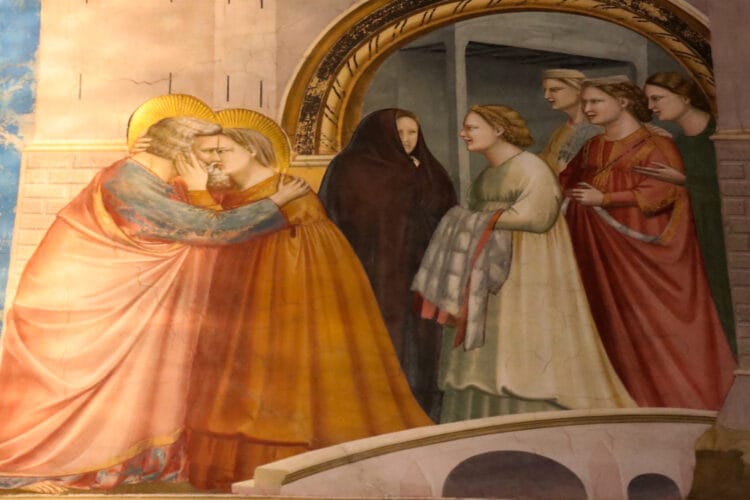
Giotto’s frescoes in the Scrovegni Chapel break from Byzantine conventions popular in medieval religious art. He eliminates the gold backgrounds and flatness in favor of realistic space, light, and anatomy. Figures are voluminous and grounded. Their faces register subtle, credible emotions. The architecture and landscape anchor the narrative in tangible space.
Giotto’s handling of drapery, light, and gesture lends his figures weight and dignity. He elevates biblical stories by portraying their characters as fully human. Grieving mothers, puzzled disciples, curious children, and angry soldiers contribute to a sacred drama that feels immediate and real.

The Scrovegni Chapel becomes more than decoration; it is a total environment of sacred narrative. It immerses the viewer in a continuum from birth to judgment, from sorrow to salvation, from earth to heaven—each scene a step in a coherent, divinely inspired journey.
Giotto’s frescoes in the Scrovegni Chapel are a tour de force of medieval art. Visionary not only for their narrative unity and emotional power, but for their embodiment of a new, human-centered sacred art. They offer a complete spiritual cosmos, seen through the lens of ordinary human experience. The result is an enduring masterpiece—one that continues to move, instruct, and inspire across centuries.
More on Padua near Venice in Italy
Padua (Padova) is a popular day-trip excursion destination from Venice, but the art and architecture here are worth a journey:
- → Top Sights to See in Padua (Padova)
- → Visit the Basilica of St Anthony — free, long opening hours.
- → How to Buy Tickets for the Scrovegni Chapel in Padua — although not very difficult to secure compulsory time-slot reservations, tickets must be bought a day in advance!
- → Giotto’s frescoes in the Scrovegni Chapel, which include the Life of Joachim and Anne: Parents of the Virgin Mary
- → By Train to Padova (for an easy day-trip or stopover from Venice)
- → Book Hotels in Padua
- → Book Luggage Storage near Padova Station